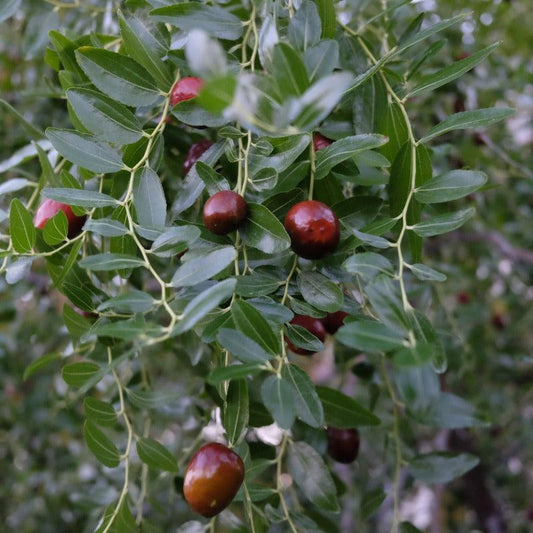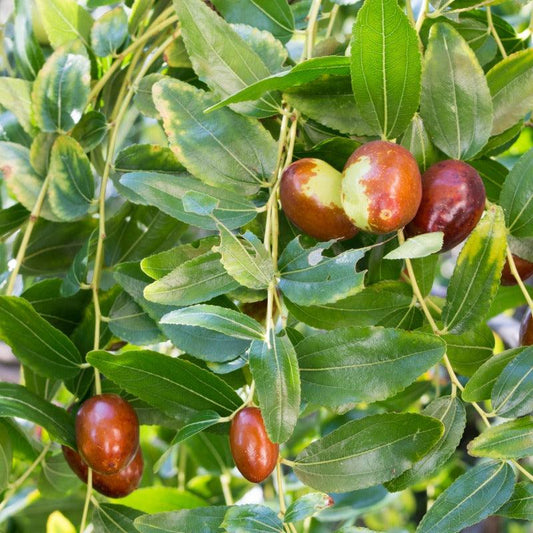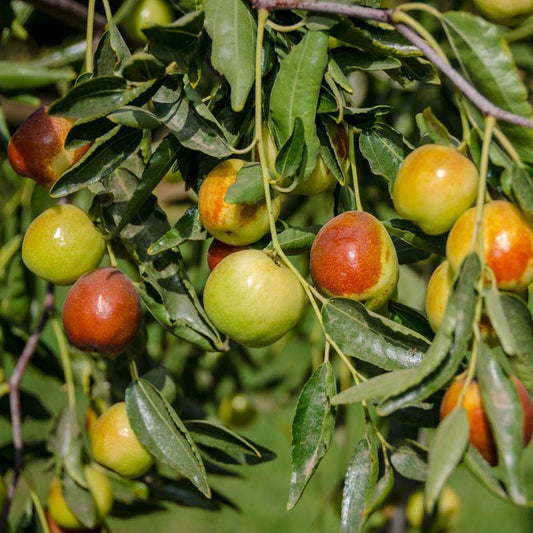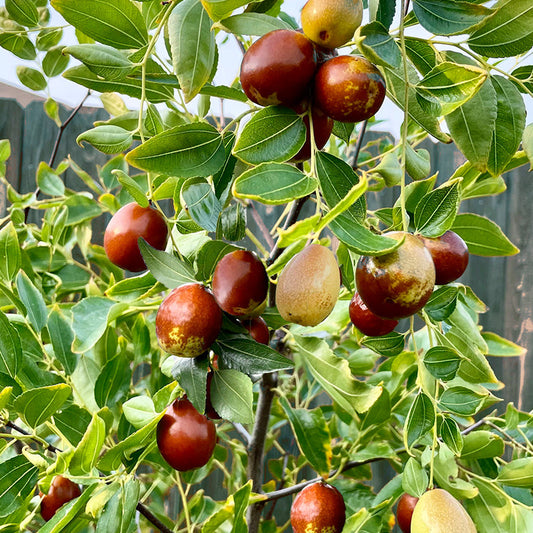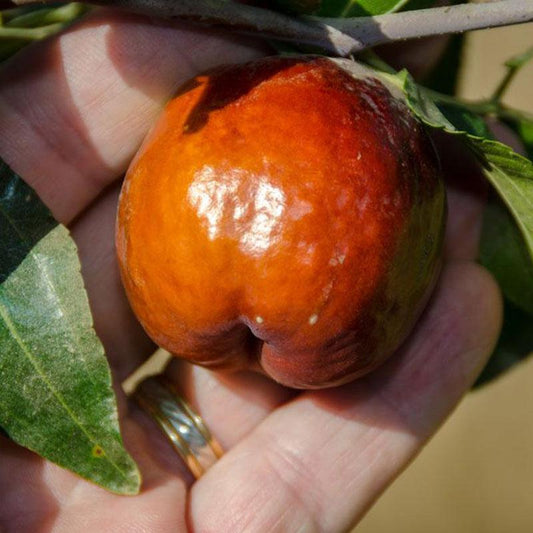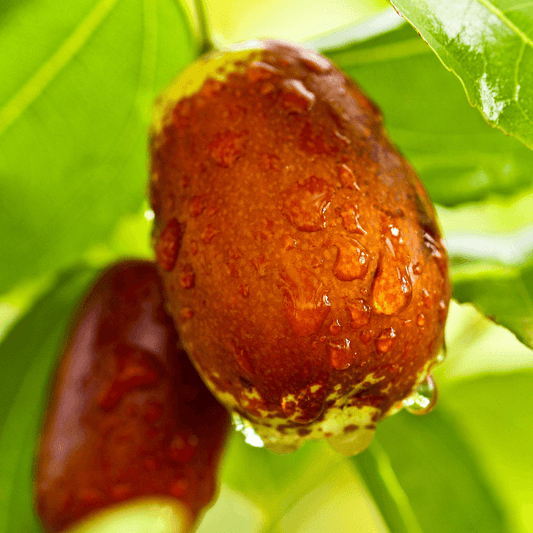The Ultimate Jujube Tree Growing Zone Guide
Jujube trees (Ziziphus jujuba), also known as Chinese dates, are beloved for their resilience, minimal care needs, and sweet, date-like fruits. These hardy fruit trees thrive where other trees might struggle, tolerating heat, drought, and even poor soil conditions.
Whether you’re looking to grow jujube trees for fresh eating or dried fruits, learning the right jujube cultivation techniques will help you produce high-quality fruit year after year.
This guide explores the ideal jujube tree growing zone, soil and climate preferences, proper jujube care, and practical tips for watering, pruning, and avoiding common issues like root rot.

Ideal Jujube Tree Growing Zone
Jujube trees thrive in USDA Hardiness Zones 6 to 9, where hot summers and cool winters encourage strong growth and excellent fruit production. They are well-adapted to the southwestern United States, as well as similar dry, warm regions. Fully established trees can withstand winter temperatures as low as -20°F, but they prefer climates with a long, warm growing season for the best fruit yield.
If you’re unsure about your local zone, check our What Is My Growing Zone tool to see if your area is suitable for jujube cultivation.
Why Grow Jujube Trees

Growing jujube trees is both practical and rewarding. These fruit trees are drought-tolerant once established, require minimal pruning, and are rarely troubled by pests and diseases.
The fruits—often pear-shaped or round—start green and turn brown or reddish when ripe. They can be eaten freshly or dried to make chewy dried jujubes that taste similar to dates.
Some popular varieties of jujube Ziziphus jujuba include:
- ‘Li’ – large, pear-shaped fruits, sweet and crisp when fresh.
- ‘Lang’ – ideal for drying, producing slightly tangy, shaped fruits.
- ‘Honey Jar’ – small, juicy, and excellent for fresh eating.
Explore our full Jujube Trees Collection to find high-quality varieties suited to your growing zone.
Climate and Sunlight Requirements
Jujube trees flourish in full sun, needing at least 6–8 hours of direct sunlight daily. Plant your tree in an open area away from large trees or buildings that might cast shade. The more sunlight your tree receives, the better the fruit production and the sweeter the fruit ripens.
They also love dry conditions and can tolerate drought with regular watering during the first year after planting. In colder zones, protect young trees with mulch and frost covers to prevent winter damage.
Soil Preferences and Preparation
Jujube trees are highly adaptable but perform best in well-drained soil with a neutral to slightly alkaline pH (around 6.5–7.5). Avoid waterlogged or compacted soil, as excess moisture can lead to root rot.
Before planting, conduct a quick soil check using a Soil pH Testing Kit. If the soil is too acidic, consider amending it with organic materials such as compost, lime, or other soil Amendments.
Learn more about pH balance and soil preparation in our guide, Understanding Soil pH.

How to Plant Jujube Trees
- Choose the Right Spot: Pick a sunny location with excellent drainage.
- Prepare the Hole: Dig a hole twice the width of the root ball and deep enough to match its height.
- Amend the Soil: Mix compost or organic matter into the backfill soil to enrich it.
- Plant and Water: Place your jujube tree upright, fill in with soil, and water deeply to settle the roots.
- Mulch for Moisture: Add a 3–4 inch layer of mulch to help retain moisture and suppress weeds. Learn more about effective mulching in Mulch: Beyond the Basics.
Fertilization and Ongoing Jujube Care
During the first few years, jujube trees benefit from light fertilization in early spring to support growth. Use a balanced organic blend such as All-Purpose Fertilizer or a Pelleted Fertilizer for slow nutrient release.
For mature trees, apply fertilizer sparingly. Too much nitrogen can encourage leafy growth at the expense of fruit yield. See our guide, When and How to Fertilize Your Fruit Trees, for more detailed timing and techniques.
Pruning and Training Your Jujube Tree
Pruning helps maintain shape, improves airflow, and increases fruit yield. In early spring, prune to remove dead or crossing branches. Jujubes can be trained to an open-center or vase shape—similar to apple or peach trees. Learn more about pruning methods in Pruning Fruit Trees: Choose Training Shapes.
Light pruning encourages new growth, which is where most jujube fruits develop. Avoid heavy pruning, as this may reduce the next season’s fruit production.

Pollination and Fruit Production
Most jujube trees are self-pollinating, but planting two or more varieties can improve cross pollination and increase your overall fruit yield.
Expect your tree to start producing fruit about 2–3 years after planting. Once mature, a well-cared-for tree can produce fruit for decades.
Common Pests and Diseases
While jujube trees are naturally resistant, occasional issues may arise, such as scale insects or fruit flies.
Monitor for pests regularly and manage them with organic options like neem oil or insecticidal soap. For seasonal care tips, see Spring Disease Control in Your Orchard.

Harvesting Fresh and Dried Jujubes
Fruit ripens from late summer to early fall, depending on variety and region. When fruits turn from green to golden-brown or reddish, they’re ready to pick.
Fresh jujubes are crisp and sweet when eaten straight from the tree, while dried jujubes develop a chewy texture and deeper flavor. Simply air-dry them or use a dehydrator for long-term storage.
For more inspiration, explore Growing Jujube Trees and How to Use the Fruit.
In Summary
The jujube tree is one of the most forgiving and rewarding fruit trees for home gardeners. With proper jujube care, full sun, and well-drained soil, these trees thrive in warm regions and reliably produce fruit year after year. Whether you prefer fresh jujubes or dried fruits, growing a Chinese date tree brings both beauty and bounty to your garden.
Discover high-quality jujube trees at Grow Organic and start your own jujube journey today.


